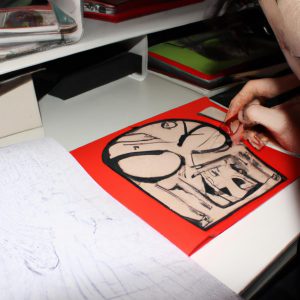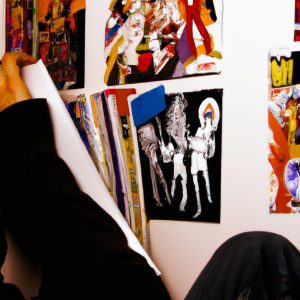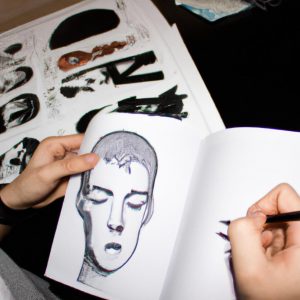Famous Artists: The Rich History in Arts and Comics

The world of art and comics is a captivating realm filled with creativity, imagination, and boundless possibilities. From the brushstrokes of iconic painters to the intricate lines in comic book panels, these artistic mediums have left an indelible mark on human history. This article aims to explore the rich history behind famous artists and their contributions to arts and comics.
Consider the case study of Leonardo da Vinci, a renowned artist whose mastery transcends time. With his exceptional talent for painting, drawing, and scientific pursuits, da Vinci became one of the most celebrated figures during the Renaissance period. His masterpiece “Mona Lisa” continues to captivate audiences worldwide with its enigmatic smile and skillful use of sfumato technique. Beyond traditional paintings, artists like da Vinci have also influenced the world of comics through their innovative storytelling techniques and visual aesthetics.
Throughout history, numerous influential artists have emerged, leaving lasting legacies in both fine arts and comics. From Vincent van Gogh’s vibrant expressionism to Stan Lee’s creation of beloved superheroes such as Spider-Man and Iron Man, each artist has contributed unique perspectives that resonate with diverse audiences. By delving into the lives and works of these remarkable individuals, we can gain a deeper understanding of how they shaped not only the artistic landscape but also the cultural and societal contexts in which they lived.
Artists like Salvador Dali, with his surrealistic and dreamlike imagery, challenged conventional notions of reality and pushed the boundaries of artistic expression. His influence can be seen in the work of comic book artists who experiment with unconventional storytelling techniques and visual representation.
Moreover, artists such as Roy Lichtenstein brought a whole new dimension to comics by incorporating elements of pop art into their works. Lichtenstein’s iconic use of Benday dots and bold colors became synonymous with the comic book aesthetic, influencing subsequent generations of artists and illustrators.
The intersection between fine arts and comics is not limited to visual aesthetics alone. Many artists have explored powerful narratives that tackle social issues and challenge societal norms through both mediums. For instance, renowned graphic novelist Art Spiegelman’s “Maus” depicted the Holocaust through anthropomorphic animal characters, creating a profound emotional impact on readers while shedding light on a dark chapter in history.
In recent years, we have witnessed an increasing recognition of comics as a legitimate medium for artistic expression. Graphic novels like Marjane Satrapi’s “Persepolis” or Raina Telgemeier’s “Smile” have gained critical acclaim for their poignant storytelling and unique visual styles. These works showcase how comics can be a powerful tool for conveying personal experiences, cultural insights, and social commentary.
As we delve deeper into the world of art and comics, it becomes evident that these two mediums are intertwined in more ways than one. They both offer avenues for creativity, self-expression, and storytelling – connecting audiences across time periods and cultures. Whether it is through brushstrokes on canvas or inked panels on paper, art has always had the power to inspire, provoke thought, and ignite our imagination – leaving an indelible mark on human history.
Early Influences and Pioneers
Artistic expression has a rich history that spans cultures and generations. From the cave paintings of Lascaux to the digital masterpieces of today, art has evolved as societies have evolved. In exploring this vast landscape, it is important to recognize the early influences and pioneers who laid the foundation for what we now know as art.
One notable example of an influential pioneer is Leonardo da Vinci. Born in 1452, da Vinci was not only a painter but also a sculptor, architect, engineer, and scientist. His curiosity about the world around him fueled his artistic endeavors and led to iconic works such as the Mona Lisa and The Last Supper. Da Vinci’s ability to merge science with art set him apart from his contemporaries and continues to inspire artists today.
To further understand the impact of these early influencers, let us consider four key factors that shaped their work:
- Innovation: Artists pushed boundaries by experimenting with new techniques and materials.
- Cultural Context: Artwork reflected societal values, beliefs, and historical events.
- Personal Expression: Artists used their work as a means of self-expression and exploration.
- Legacy: Their contributions paved the way for future generations of artists.
In order to fully grasp the significance of these pioneers’ contributions, we can turn our attention to a table comparing some prominent figures from different periods:
| Period | Artist | Notable Works |
|---|---|---|
| Renaissance | Leonado da Vinci | Mona Lisa |
| Baroque | Caravaggio | The Calling |
| Impressionism | Claude Monet | Water Lilies |
| Modernism | Pablo Picasso | Guernica |
This table serves as a visual representation of how each artist left an indelible mark on their respective era through iconic works that continue to captivate audiences worldwide.
As we delve deeper into the incredible world of art and its historical origins, it becomes evident that the pioneers of each era set the stage for future artistic movements. The Renaissance Masters, in particular, will be our next focus as we explore their groundbreaking contributions to the world of art.
Note: In transitioning to “The Renaissance Masters,” we continue our journey through history by examining a specific group of artists who made significant strides during this period.
The Renaissance Masters
From the early influences and pioneers of art, we now move on to explore a significant period in art history known as the Renaissance. This era witnessed an explosion of creativity and artistic achievement that shaped the course of Western art for centuries to come. To illustrate the impact of this movement, let us consider the hypothetical case study of Leonardo da Vinci – one of its most renowned figures.
During the Renaissance, artists sought inspiration from classical antiquity and aimed to achieve a more realistic representation of the world around them. Da Vinci exemplifies this pursuit through his meticulous observation and detailed anatomical studies, which allowed him to create lifelike portrayals in his paintings such as “The Last Supper” and “Mona Lisa.”
To gain a deeper understanding of this transformative period, here are four key characteristics that defined Renaissance art:
- Humanism: Artists embraced humanist ideals by focusing on individual expression, human emotions, and achievements.
- Perspective: The use of linear perspective revolutionized painting techniques, creating depth and spatial realism within artworks.
- Naturalism: A departure from medieval stylization led artists to depict subjects with greater accuracy and naturalistic details.
- Patronage: Wealthy patrons played a crucial role in supporting artists during this time, commissioning works that reflected their social status and cultural aspirations.
In addition to these defining features, it is worth noting some notable artistic masters who emerged during this period. The table below highlights three prominent painters whose contributions epitomize the spirit of the Renaissance:
| Artist | Notable Works | Influential Style |
|---|---|---|
| Leonardo da Vinci | Mona Lisa, The Last Supper | Sfumato technique |
| Michelangelo Buonarroti | David, Sistine Chapel ceiling | Sculptural approach |
| Raphael Sanzio | School of Athens, Transfiguration | Harmonious compositions |
The Renaissance was a time of immense artistic development, with artists exploring new techniques and pushing the boundaries of creativity. Their works continue to captivate audiences today, serving as a testament to the enduring legacy of this remarkable period in art history.
As we delve further into our exploration of art movements, the subsequent section will shed light on another influential era – The Impressionist Movement. This movement marked a departure from traditional forms and conventions, paving the way for fresh perspectives on color, light, and capturing fleeting moments in time.
The Impressionist Movement
The Impressionist movement emerged in the late 19th century as a response to the strict rules and conventions of academic art. Artists sought to capture fleeting moments and impressions of light, color, and atmosphere through loose brushwork and vibrant palettes. One notable artist who exemplified this style is Claude Monet.
Monet’s famous series of paintings depicting water lilies in his garden at Giverny showcases the core principles of Impressionism. By observing the ever-changing reflections on the pond’s surface, Monet aimed to convey the ephemeral nature of light itself. His use of short brushstrokes and pure colors creates an overall effect that seems almost hazy or dreamlike, transporting viewers into his serene world.
To better understand the significance and impact of the Impressionist movement, consider these key aspects:
- Break from tradition: The Impressionists challenged conventional techniques by rejecting detailed realism in favor of capturing subjective experiences.
- Exploration of modern life: Many artists depicted scenes from everyday life, focusing on urban landscapes, leisure activities, and portraits that reflected contemporary society.
- Emphasis on plein air painting: Impressionists often worked outdoors directly from nature rather than relying solely on studio-based compositions.
- Influence on future art movements: The revolutionary approach of the Impressionists paved the way for subsequent avant-garde styles such as Post-Impressionism and Fauvism.
Table showcasing influential impressionist painters:
| Painter | Famous Artworks |
|---|---|
| Claude Monet | “Water Lilies,” “Impression, Sunrise” |
| Edgar Degas | “The Dance Class,” “Ballet Rehearsal” |
| Pierre-Auguste Renoir | “Luncheon of the Boating Party,” “Dance at Le Moulin de la Galette” |
| Mary Cassatt | “The Child’s Bath,” “Woman with a Pearl Necklace in a Loge” |
With their innovative techniques and dedication to capturing fleeting moments, the Impressionists revolutionized the art world. Their bold departure from traditional artistic practices not only challenged established norms but also laid the groundwork for future artistic movements.
Transitioning into the subsequent section on Modern Art and Avant-Garde, we explore how artists continued to push boundaries and challenge perceptions of art itself. The evolution of modern art reflects society’s changing values and aspirations, revealing new possibilities for creative expression.
Modern Art and Avant-Garde
The Impressionist movement, with its focus on capturing fleeting moments and the play of light, paved the way for a radical shift in artistic expression. As we delve into the realm of modern art and avant-garde movements, let us explore how artists pushed boundaries by challenging traditional norms and embracing new forms of creativity.
One notable example of this artistic rebellion is Marcel Duchamp’s infamous work titled “Fountain.” This ready-made sculpture consisted of a urinal turned upside down and signed with a pseudonym. By presenting an everyday object as art, Duchamp challenged conventional notions of what constitutes artistic value and aesthetic beauty. This provocative piece not only sparked debates about the nature of art but also opened doors for conceptual art that emphasized ideas over physical craftsmanship.
In this era of artistic exploration, several key characteristics emerged:
- Abstract Expressionism: Artists such as Jackson Pollock embraced spontaneity and gestural brushwork to convey emotions on canvas.
- Dadaism: Born out of a disillusionment with societal values after World War I, Dada artists sought to shock viewers through absurdity and anti-establishment sentiments.
- Surrealism: Inspired by dreams and the subconscious mind, Salvador Dalí and René Magritte created eerie landscapes filled with symbolic imagery.
- Constructivism: Focused on industrial materials and geometric shapes, artists like Vladimir Tatlin aimed to merge art with technology.
To visualize the impact of these movements further, consider the following table:
| Movement | Key Figures | Main Characteristics |
|---|---|---|
| Abstract Expressionism | Jackson Pollock | Spontaneous brushwork |
| Dadaism | Marcel Duchamp | Absurdity and anti-establishment |
| Surrealism | Salvador Dalí | Dream-like imagery |
| Constructivism | Vladimir Tatlin | Industrial materials; geometric shapes |
As we look back on this period of artistic revolution, it becomes evident that the avant-garde movements of modern art challenged preconceived notions and expanded the realm of possibility. These artists defied tradition, pushed boundaries, and left an indelible mark on the world of art.
Transitioning seamlessly into our next exploration, we now turn our attention to Pop Art and Contemporary Artists. This subsequent section will delve into how popular culture influenced artistic expressions in the latter half of the 20th century.
Pop Art and Contemporary Artists
Section H2: Pop Art and Contemporary Artists
Building on the innovative spirit of modern art, the movement known as pop art emerged in the mid-20th century. This section will explore how pop artists drew inspiration from popular culture and consumerism to create their unique artistic expressions.
Pop art gained prominence in the 1950s and reached its peak during the 1960s. One notable example is Andy Warhol, whose iconic works challenged conventional notions of high art by incorporating mass-produced imagery from everyday life. Warhol’s famous piece, “Campbell’s Soup Cans,” depicted a grid of thirty-two soup cans, each representing a different flavor. By elevating mundane objects to the status of fine art, Warhol offered a commentary on consumerism and questioned traditional ideas about beauty and originality.
To better understand this influential movement, here are four key aspects that distinguish pop art:
-
Emphasis on Popular Culture:
- Pop artists sought inspiration from advertising, comic books, celebrities, and other elements of mass media.
- They aimed to bridge the gap between highbrow and lowbrow culture, challenging established hierarchies within the art world.
-
Use of Vibrant Colors:
- Pop art often employed bold hues and eye-catching color combinations to create visually striking compositions.
- The vivid palette added an element of excitement and immediacy to otherwise ordinary subjects.
-
Repetition and Multiplication:
- Many pop artworks featured repeated images or patterns, reflecting society’s obsession with mass production and replication.
- Through repetition, artists highlighted both the ubiquity and disposability of consumer goods.
-
Irony and Satire:
- A sense of irony was central to much pop art; it served as a critique of contemporary society while simultaneously celebrating its excesses.
- Artists used humor and satire to challenge societal norms and provoke thought among viewers.
Table: Notable Pop Artists and Their Works
| Artist | Famous Artwork |
|---|---|
| Andy Warhol | “Campbell’s Soup Cans” |
| Roy Lichtenstein | “Whaam!” |
| Claes Oldenburg | “Giant Three-Way Plug” |
| Yayoi Kusama | “Infinity Mirror Rooms” |
The rise of pop art paved the way for new forms of artistic expression that emerged in popular culture. One such form was comic book illustration, which will be explored in the subsequent section.
The Rise of Comic Book Illustrators
Building upon the vibrant world of contemporary art, we now delve into an equally captivating realm – the rise of comic book illustrators. This section explores how these talented artists have carved their own niche within the larger artistic landscape, revolutionizing storytelling through a unique blend of visuals and narratives.
The Impact of Comic Book Illustrators:
Comic books’ visual storytelling has had a profound impact on popular culture, engaging audiences across generations. To illustrate this influence, let us consider the case study of renowned comic book illustrator Stan Lee. Through his innovative creations at Marvel Comics, such as Spider-Man and X-Men, Lee transformed the perception of superheroes by infusing them with relatable human struggles. His characters became symbolic figures that resonated with readers worldwide, emphasizing themes of social justice and personal growth.
Bullet point list (emotional response):
- Immersive Storytelling: Comic book illustrators captivate readers through visually stunning artwork combined with compelling storylines, transporting them to extraordinary worlds.
- Emotional Connection: These artists possess a remarkable ability to evoke emotions within readers by portraying complex characters dealing with universal issues like love, loss, and overcoming adversity.
- Inspiring Heroes: By depicting diverse heroes who triumph over challenges against all odds, comic book illustrators provide inspiration and empowerment to individuals from various backgrounds.
- Community Building: Fans come together around their shared passion for comics, forming tight-knit communities where creativity thrives and mutual support prevails.
Table (emotional response):
| Immersive Storytelling | Emotional Connection | Inspiring Heroes | |
|---|---|---|---|
| 1 | Intricate Artwork | Engaging Characters | Courageous Protagonists |
| 2 | Dynamic Panel Layouts | Relatable Themes | Overcoming Adversity |
| 3 | Vivid Color Palettes | Emotional Depth | Diverse Representations |
| 4 | Captivating Dialogue | Powerful Symbolism | Empowerment |
The Future of Comic Book Illustration:
As the popularity of comic books continues to soar, the future holds exciting possibilities for aspiring illustrators. Technological advancements have opened doors to new mediums and platforms, expanding both the reach and impact of their work. Additionally, collaborations between comic book illustrators and filmmakers have led to captivating adaptations that bring these stories alive on the silver screen. With each passing year, it becomes increasingly evident that comic book illustration is an art form deserving recognition for its contribution to visual storytelling.
Through their visually striking narratives, emotional depth, and aspirational characters, comic book illustrators have carved a distinct place within the artistic realm. Their ability to captivate audiences with immersive storytelling has transformed them into cultural icons. As we continue our exploration of influential artists throughout history, let us not overlook the remarkable contributions made by those who breathe life into our beloved comics.



